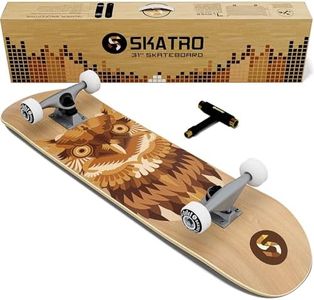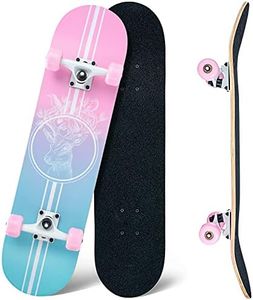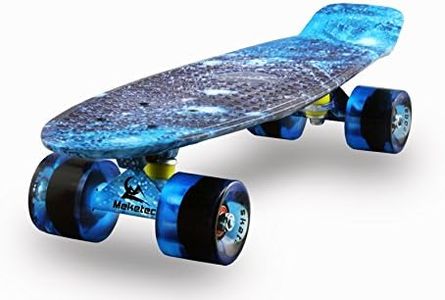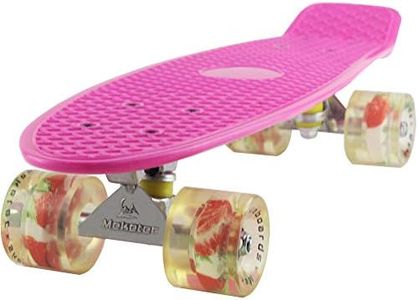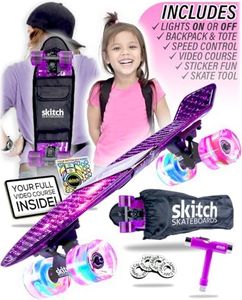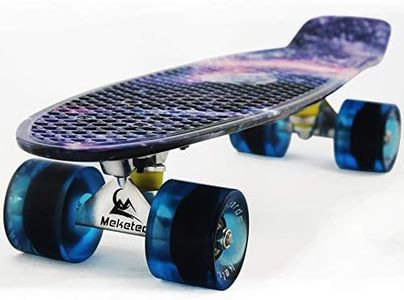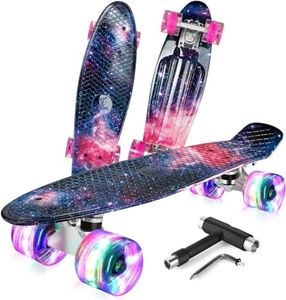We Use CookiesWe use cookies to enhance the security, performance,
functionality and for analytical and promotional activities. By continuing to browse this site you
are agreeing to our privacy policy
10 Best Beginner Skateboards
From leading brands and best sellers available on the web.Buying Guide for the Best Beginner Skateboards
Choosing your first skateboard is all about finding something that matches your style, comfort, and riding goals. As a beginner, you want a board that makes it easy to learn the basics, helps you balance, and can handle a bit of rough use as you practice. It's important to pay attention to size, shape, components, and overall build quality—since these factors can make a huge difference in how enjoyable and safe your learning experience will be.Deck WidthDeck width refers to how wide the skateboard is from side to side. This is important because the width affects your balance and control; wider boards usually are more stable, which is useful for beginners, while narrower boards are easier to flip and turn, which is more suitable for tricks. Deck widths typically range from about 7.5 to 8.5 inches. If your feet are on the larger side or you want lots of stability, go for something on the wider end; if your feet are smaller or you want something easier to maneuver, a narrower board may suit you better. As a beginner, stability is usually more important, so don't be afraid to start wider.
Deck LengthDeck length measures how long the skateboard is from the tip of the nose to the tail. Longer boards offer more space and stability, making them ideal for those who are taller or for absolute beginners who are looking for balance. Shorter boards are easier to carry and turn, but may feel less stable. Most standard skateboards for beginners have a length around 31 to 33 inches. You should consider your own height and comfort when standing on the board: a little extra length can help you feel secure as you learn.
Deck MaterialMost skateboard decks are made from layers of pressed maple wood, which provides a good balance of strength and flexibility. Some may combine additional materials like bamboo or fiberglass for added durability or lightness. For beginners, sticking with traditional maple is usually a safe bet, as it's tough and predictable underfoot. The material impacts how the board flexes, which can affect comfort and how easy it is to learn new tricks.
TrucksTrucks are the metal parts that attach the wheels to the deck. Their width should match the width of your deck; if they're too narrow or too wide, you might have trouble turning or balancing. The kingpin (the center bolt) can be loose for easier turning or tight for more stability. For beginners, medium height and width trucks that fit your deck and aren't too loose or too tight are ideal for all-around learning. If you plan to mostly cruise and learn basic tricks, these will handle well.
WheelsSkateboard wheels come in different sizes (diameter) and hardness (durometer). Larger wheels (about 54-59mm) roll over cracks and rough pavement more smoothly, while smaller wheels (50-53mm) are better for tricks. Softer wheels grip better and give a smoother ride, while harder wheels are faster on smooth surfaces like skateparks. As a beginner, slightly larger and softer wheels will help you stay comfortable and in control, especially if you're learning outside on various surfaces.
BearingsBearings are small devices inside the wheels that let them spin. They have ratings like ABEC, which measures precision, but for beginners, most standard bearings are sufficient. They're important because they determine how smoothly and quickly the wheels turn. As a beginner, you don't have to worry too much about high-end bearings—just make sure they're smooth and not too fast, which helps you stay in control while learning.
Grip TapeGrip tape is the rough, sandpaper-like material on top of the deck that helps your shoes stick to the board. Good grip tape is important so you don't slip off as you're learning. Most skateboards come with standard black grip tape, which is more than enough for beginners. Make sure the grip is even and covers the entire standing area so you feel secure on your board.
